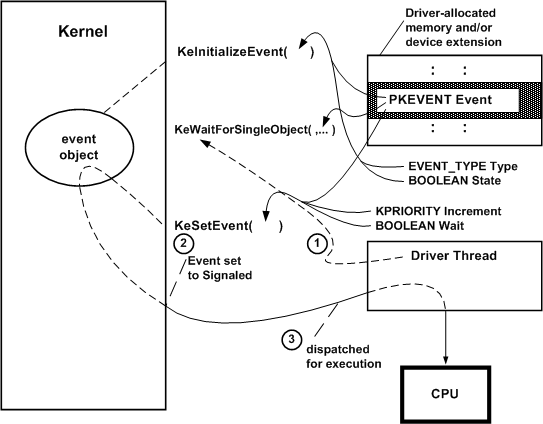Defining and Using an Event Object
Any driver that uses an event object must call KeInitializeEvent, IoCreateNotificationEvent, or IoCreateSynchronizationEvent before it waits on, sets, clears, or resets the event. The following figure illustrates how a driver with a thread can use an event object for synchronization.

As the previous figure shows, such a driver must provide the storage for the event object, which must be resident. The driver can use the device extension of a driver-created device object, the controller extension if it uses a controller object, or nonpaged pool allocated by the driver.
When the driver calls KeInitializeEvent, it must pass a pointer to the driver's resident storage for the event object. In addition, the caller must specify the initial state (signaled or not signaled) for the event object. The caller also must specify the event type, which can be either of the following:
SynchronizationEvent
When a synchronization event is set to the Signaled state, a single thread that is waiting for the event to be reset to Not-Signaled becomes eligible for execution and the event's state is automatically reset to Not-Signaled.
This type of event is sometimes called an autoclearing event, because its Signaled state is automatically reset each time a wait is satisfied.
NotificationEvent
When a notification event is set to the Signaled state, all threads that were waiting for the event to be reset to Not-Signaled become eligible for execution and the event remains in the Signaled state until an explicit reset to Not-Signaled occurs: that is, there is a call to KeClearEvent or KeResetEvent with the given Event pointer.
Few device or intermediate drivers have a single driver-dedicated thread, let alone a set of threads that might synchronize their operations by waiting for an event that protects a shared resource.
Most drivers that use event objects to wait for the completion of an I/O operation set the input Type to NotificationEvent when they call KeInitializeEvent. An event object set up for IRPs that a driver creates with IoBuildSynchronousFsdRequest or IoBuildDeviceIoControlRequest is almost always initialized as a NotificationEvent because the caller will wait for the event for notification that its request has been satisfied by one or more lower-level drivers.
After the driver has initialized itself, its driver-dedicated thread, if any, and other routines can synchronize their operations on the event. For example, a driver with a thread that manages the queuing of IRPs, such as the system floppy controller driver, might synchronize IRP processing on an event, as shown in the previous figure:
The thread, which has dequeued an IRP for processing on the device, calls KeWaitForSingleObject with a pointer to the driver-supplied storage for the initialized event object.
Other driver routines carry out device the I/O operations necessary to satisfy the IRP and, when these operations are complete, the driver's DpcForIsr routine calls KeSetEvent with a pointer to the event object, a driver-determined priority boost for the thread (Increment, as shown in the previous figure), and a Boolean Wait set to FALSE. Calling KeSetEvent sets the event object to the Signaled state, thereby changing the waiting thread's state to ready.
The kernel dispatches the thread for execution as soon as a processor is available: that is, no other thread with a higher priority is currently in the ready state and there are no kernel-mode routines to be run at a higher IRQL.
The thread now can complete the IRP if the DpcForIsr has not called IoCompleteRequest with the IRP already, and can dequeue another IRP to be processed on the device.
Calling KeSetEvent with the Wait parameter set to TRUE indicates the caller's intention to immediately call a KeWaitForSingleObject or KeWaitForMultipleObjects support routine on return from KeSetEvent.
Consider the following guidelines for setting theWaitparameter toKeSetEvent:
A pageable thread or pageable driver routine that runs at IRQL < DISPATCH_LEVEL should never call KeSetEvent with the Wait parameter set to TRUE. Such a call causes a fatal page fault if the caller happens to be paged out between the calls to KeSetEvent and KeWaitForSingleObject or KeWaitForMultipleObjects.
Any standard driver routine that runs at IRQL = DISPATCH_LEVEL cannot wait for a nonzero interval on any dispatcher objects without bringing down the system. However, such a routine can call KeSetEvent while running at an IRQL less than or equal to DISPATCH_LEVEL.
For a summary of the IRQLs at which standard driver routines run, see Managing Hardware Priorities.
KeResetEvent returns the previous state of a given Event: whether it was set to Signaled or not when the call to KeResetEvent occurred. KeClearEvent simply sets the state of the given Event to Not-Signaled.
Consider the following guideline for when to call the preceding support routines:
For better performance, every driver should call KeClearEvent unless the caller needs the information returned by KeResetEvent to determine what to do next.